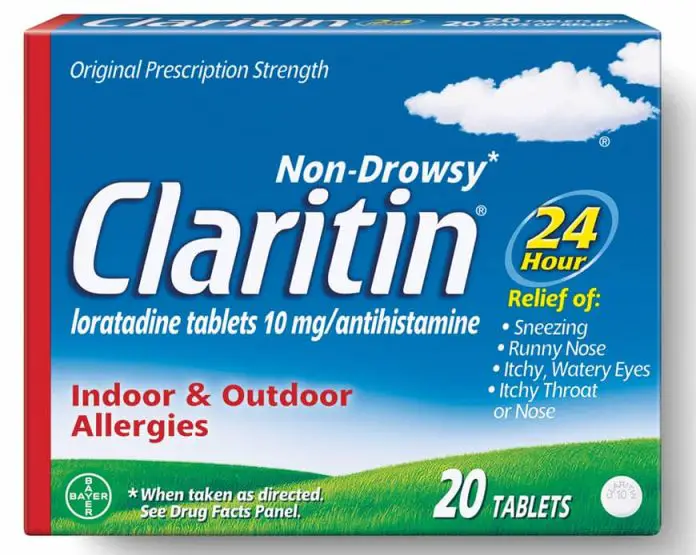
Is your dog suffering from itching, sneezing, and runny nose? It could be an allergy. You might be wondering if you can administer antihistamines to alleviate these symptoms. In today’s post, we will take a look at canine allergies and how to properly use a human medication like Claritin in treating allergy symptoms in dogs.
What is Claritin?
Claritin is a brand of Loratadine, an antihistamine used for treating seasonal allergies in humans. It is used for treating skin itching, sneezing, coughing, and runny nose. In some instances, it is also used for occasional vomiting.
Loratadine works by binding with the H1 receptor, one of the four histamine receptors that are responsible for the ileum contraction, modulate circadian cycle, itching, systemic vasodilation, and allergy-induced asthma.
The H1 receptor is located on the blood vessels and can also be found on the gastrointestinal tract, heart, and central nervous system. As an H1 receptor antagonist, Loratadine works by blocking the effects of histamine that causes the allergic symptoms. This results in reduced itchiness and swelling.
Loratadine is among the second generation of antihistamines.According to the “Clinical Veterinary Toxicology”, the newer generation of antihistamines lack the sedative properties present in the first generation. However, both generations have equal potency in blocking the H1 receptor but there are differences in terms of their effect on the central nervous system.
While non-sedative, Loratadine it has similar placeboeffects. Studies suggest that Loratadine has an adverse effect on working memory and psychomotor performance. It can induce very minimal sedation at a prescribed dose but can cause impairment if ingested in higher doses.
Is Claritin Safe For Dogs?
Yes, Claritin is safe for dogs. Compared to other brands of antihistamines, Claritin is the safer choice. Benadryl, for instance, is also effective in treating allergy symptoms in canines but it has a more sedative effect than Claritin.
In spite of its safety and efficacy, it should only be administered under a veterinarian’s supervision. The Food and Drug Administration (FDA) has not approved the use of Loratadine for animals and only licensed veterinarians are legally allowed to prescribe it as an extra-label medication.
Do note that Claritin comes in various types and doses. There is a certain type that you cannot give to a dog, namely Claritin-D, which is a combination of Loratadine and Decongestant. Even if your vet already approved the use of Claritin for your pet, you have to be careful when buying this over-the-counter medication. It should not be mistaken for Claritin-D.
While most antihistamines combined with a decongestant are marked with a “D,” there are a few brands that don’t have this indication in their names. Examples of combination drugs without the “D” mark are Ceron, Ryneze, and Zymine. Take extra caution and read the labels before administering any OTC drug to your pet.
Vets and dog experts continue to warn about using decongestants for dogs. Decongestants have a moderate to severe level of toxicity in canines. While there are a few safe decongestants for dogs, they should still be administered under a vet’s guidance. The symptoms of decongestant poisoning are the following:
- Vomiting
- Changes in blood pressure
- Tremors
- Increased/slow heart rate
If your pet ingested any OTC drug containing decongestant, bring him to an emergency veterinarian right away. Dogs can be safely given the Claritin formula for children but never the one formulated with a decongestant.
Cold and allergy medications, particularly decongestants can be pretty dangerous for canines. In fact, decongestants are listed as one of the Top 10 canine toxins because of their content of pseudoephedrine which is poisonous to canines. When the dosage is high enough, it can inherently kill a dog.
What Are the Side Effects of Claritin in Dogs?
Claritin has minimal side effects to canines. If side effects appear, they are usually dry eyes and mouth as well as an increased need for water. Your dog may also end up drowsy and looking confused after taking Claritin. It’s also normal to see some changes in his stool and also in his usual behavior.
In rare cases, Loratadine may cause hyperactivity, depression, and tachycardia. Do note that dogs react differently to certain medications. If your dog looks like he has a strong reaction to Claritin, tell your vet about it before giving the next dose.
In extremely high doses, Claritin can also cause hyperactivity and ataxia or loss of coordination. Keep the medicine out of your pet’s reach, as much as possible at a height that is not easily accessible by your pet. The medicine vials should also be properly closed to prevent spilling.
What to Do If Your Dog Ate Some Claritin Tablets?
Have you accidentally dropped your pills on the floor and your pet just ate them before you could pick them all up? Or was there a time when you came home to see that your buddy chewed a vial of your medication?
If you suspect that your dog swallowed some Claritin tablets, keep an eye for symptoms such as mild sedation. More often than not, this goes away after 24 hours as the drug is naturally removed from the dog’s system.
Induced vomiting is only safe if the ingestion happened an hour or less before. This is done by giving the pet a tablespoon of 3% hydrogen peroxide orally. The substance will cause a dog to throw up after around 10 minutes.
If the mild sedation or any other symptoms are still present after the 24-hour mark, rush him to the nearest veterinary emergency center. If you don’t have one nearby, you may call a pet poison helpline for instant access to veterinary assistance.
How Much Claritin is Safe for Dogs?
The allowed dosage of Claritin for canines is 0.25 milligrams for each pound of body weight. If your dog weighs less than 15 pounds, less than a 5 milligram per day is a safe amount.
For dogs weighing 15-39 pounds, it’s safe to administer 10 milligrams once a day. They can also take two 5 milligrams doses of Claritin per day. Canines weighing 40 pounds or more can be safely given 10 milligrams of Claritin twice a day.
What You Need to Know About Canine Allergies
Seasonal allergies are also referred to as seasonal allergic rhinitis. Like us, dogs can also suffer from seasonal allergies. The only difference is that they can get them in the form of skin irritation or inflammation. Around 70% of all skin irritations in dogs are actually due to allergies. Keep an eye for the following symptoms:
- Rashes
- Hives
- Reddened skin
- Swelling in the face and throat
There are many possible causes of canine allergies. The top three causes of allergies in dogs are food, environment, and fleas. It is crucial to know the root cause of an allergic reaction before starting with any medication.
Antihistamines such as Claritin are only meant to relieve the symptoms of an allergic dog. They are just a temporary fix to the symptoms associated with your pet’s allergies. There is no such thing as a cure for canine allergies. They cannot be cured but there are a lot of ways to manage them.
Identifying the cause is the only way to successfully manage your pet’s allergy. Once you identified the culprit, it is easier to control the outbreaks. If your pet is allergic to a certain food, you will eventually need to tweak his diet. If it’s an environmental or flea allergy, you need to take extra measures to clean your surroundings.
When Not To Give Claritin to Dogs
Don’t administer Claritin to your pet if he has a liver or kidney problem. Canines with liver or kidney issues may not be able to handle Claritin well.
Also let your vet know if your pet is taking other medications. Certain medications should not be taken along with Claritin because the risks of their interactions could outweigh their benefits.
Claritin should not be given to pregnant and nursing dogs. Studies suggest that a small percentage of the dose can pass through milk. If a pregnant or nursing dog is currently suffering from allergies, it is better to treat her using natural remedies.
Natural Alternatives to Loratadine
Loratadine and all antihistamines, in general, are among the inexpensive ways to treat canine allergies but it is possible that this antihistamine may not be effective in all patients.
While Loratadine is safe for dogs, there are dog owners who are still quite hesitant to administer the drug to their pets. Here are just some of the natural and safer substitutes to Loratadine:
- Oat baths – colloidal oatmeal is often used as an ingredient in anti-itch shampoos. It can be used to provide temporary relief to itching. If you prefer a more natural approach, you may use regular oatmeal. Simply grind it until it becomes powder and gently rub it in your pet’s skin and coat during his bath time. You can also put the crushed oatmeal in your dog’s tub and let him soak in it for roughly 10 minutes.
- Epsom salts – apart from oatmeal, you can also use Epsom salt in your pet’s bathing water for an extra soothing effect. Mix half a cup of this salt with a gallon of water. It can also be added in warm water and let your dog soak in it or use it for rinsing.
- Chickweed – this healing herb is used in gels and ointments because of its ability to relieve itching. Most creams containing this herb are used to treat eczema, boils, psoriasis, and even wounds. To make a chickweed poultice for your dog, simmer the leaves.
- Thyme – due to its antiseptic and antifungal properties, thyme can be used in treating itchy dog skin. This is best used in the form of essential oil. All you need to do is add a few drops of thyme essential oil to your pet’s rinse water. Do note that essential oils should be correctly dilutedbefore using them on your dog’s coat.
- Aloe vera – because allergies in dogs often show in the form of skin itching, it is a must to treat them with something that has antifungal and antibacterial properties. For that matter, aloe can be a perfect remedy.
- Chamomile – available in the form of 2% cream, chamomile can be an effective topical in treating skin irritations. Chamomile is best known for its calming properties and can be used as a temporary fix to irritated, dry, and itchy skin. Be careful though, because some dogs might be hypersensitive to daisies and ragweed.
- Coconut oil – known for its antibacterial and antifungal properties, coconut oil is another safe and natural remedy for skin irritations. It can be safely given orally or applied directly to the affected area. If you want to give it to your dog orally, you can start at ¼ of the recommended dose, which is a teaspoon for every 10 pounds of body weight.
- Apple cider vinegar – you can add some apple cider vinegar to your dog’s post-rinse water. Simply add 3 tablespoons of it to a quart of water. Just make sure to avoid the eyes when rinsing with ACV.
Apart from these, also ask your vet about Quercetin and Omega-3 supplements. Quercetin is a bioflavonoid that turns off histamine production. Quercetin supplements can be given to dogs to moderate the effects of inflammations. Omega-3, on the other hand, can drastically decrease inflammations while maintaining the kidney function.
Conclusion
Claritin has a high margin of safety for dogs. Still, it should be used with a veterinarian’s consent. Your vet will decide the dosage for your dog depending on his weight. There are a few risks involved when giving medication to your dog without a vet’s supervision. It’s always a good idea to talk to your pet doctor before administering any new medication to your furry friend.





















